View in other NatureServe Network Field Guides
NatureServe
Montana
Utah
Wyoming
Idaho
Wisconsin
British Columbia
South Carolina
Yukon
California
New York
Eastern Fox Squirrel - Sciurus niger
State Rank Reason (see State Rank above)
Within it's native range, the species is common to uncommon in deciduous woodlands. It appears to be stable and faces threats from clearing of riparian forest.
General Description
A large squirrel that is highly variable in color, both individually and geographically. Over most of the range, the pelage is rusty yellowish with a pale yellow to orange (or light gray to dirty white) belly and a bushy tail bordered with fulvous-tipped hairs. In the Southeast, body may be sprinkled with yellow, white, and black, with the head mostly blackish except for the whitish nose and ears. In the vicinity of the Delmarva Peninsula, color may be pure steel-gray with no fulvous (Burt and Grossenheider 1964). Melanism is not uncommon. For adults, total length is 454 to 698 mm, tail length is 200 to 330 mm, and hind foot length is 51 to 82 mm (Hall 1981). Mass is 696 to 1361 g, with an average of about 800 g. There is a total of 20 teeth. The bones fluoresce bright red under longwave ultraviolet light (unique among normal adult mammals) (Flyger and Gates 1982). The Eastern Fox Squirrel of the southeastern Coastal Plain of North America is the largest tree squirrel in the western hemisphere. (Weigl et al. 1989) reported an average mass of 1006 g in North Carolina and 962 g for 44 specimens collected in the Carolinas and northern Georgia. Western Fox Squirrels tend to be smaller (600 to 900+ g).
Diagnostic Characteristics
Larger than Sciurus carolinensis, in which adults are 383 to 525 mm in total length and 340 to 700 g; also, S. niger has four cheek teeth on each side of the upper jaw (S. carolinensis usually has five), and in S. niger the tail hairs generally are not tipped with white (Flyger and Gates 1982).
Species Range
Montana Range
Range Descriptions
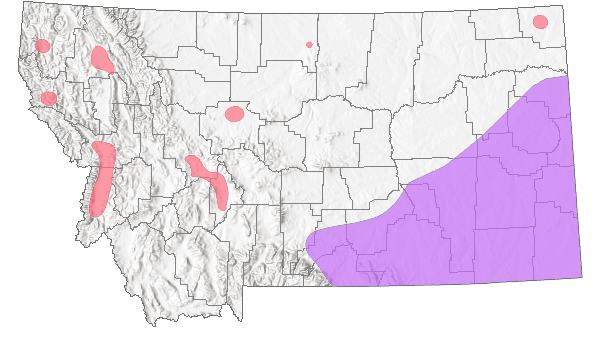 Global Range
Global Range

Estimated global breeding range area is: 6,973,340 km
2 (Approximately 1% in Montana)
See information about
 iNaturalist Geomodels
iNaturalist Geomodels
Observations in Montana Natural Heritage Program Database
Number of Observations: 365
(Click on the following maps and charts to see full sized version)
Map Help and Descriptions
Relative Density
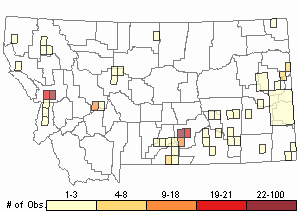
Recency
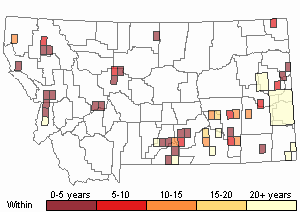

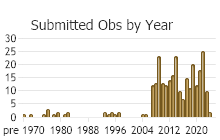
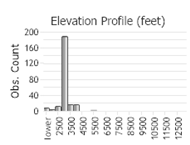 (Observations spanning multiple months or years are excluded from time charts)
(Observations spanning multiple months or years are excluded from time charts)
Migration
Non-migratory.
Habitat
Riparian cottonwood forests. Riparian stands of box elder, green ash, plains cottonwood, and willow and town parks. More prone to open forests than S. carolinensis.
National Vegetation Classification System Groups Associated with this Species
Forest and Woodland
Deciduous Forest and Woodland
Wetland and Riparian
Riparian and Wetland Forest
Riparian Shrubland
Human Land Use
Developed
Food Habits
More adaptable than S. carolinensis--nuts, seeds, corn, buds, flowers, tubers, bulbs, roots, arthropods, and birds' eggs. Scatter hoards of fall mast crops in shallow holes.
Ecology
Home ranges may be about 18.5 acres for adult males, 8.75 acres for adult females, 7.5 acres for juveniles, and 37.5 acres for juvenile males. Homerange size and population density determined by habitat quality and food crops.
Reproductive Characteristics
In Montana probably 2 peaks: December to January and April to June. Variable. Young may be born from February to September. Reach sexual maturity in 10 months.
Stewardship Responsibility
References
- Literature Cited AboveLegend:
 View Online Publication
View Online Publication Burt, W.H. and R.P. Grossenheider. 1964. A field guide to the mammals. Houghton Mifflin Co.
Burt, W.H. and R.P. Grossenheider. 1964. A field guide to the mammals. Houghton Mifflin Co. Flyger, V., and J.E. Gates. 1982. Fox and gray squirrels. Pages 209-229 in J. A. Chapman and G. A. Feldhamer, editors. Wild mammals of North America: biology, management, and economics. Johns Hopkins Univ. Press, Baltimore.
Flyger, V., and J.E. Gates. 1982. Fox and gray squirrels. Pages 209-229 in J. A. Chapman and G. A. Feldhamer, editors. Wild mammals of North America: biology, management, and economics. Johns Hopkins Univ. Press, Baltimore. Hall, E.R. 1981. The mammals of North America, volumes I and II. John Wiley & Sons, New York, NY. 1181 pp.
Hall, E.R. 1981. The mammals of North America, volumes I and II. John Wiley & Sons, New York, NY. 1181 pp. Weigl, P.D., M.A. Steele, L.J. Sherman, J.C. Ha and T.S. Sharpe. 1989. The Ecology of the fox squirrel (Sciurus niger) in North Carolina: implications for survival in the Southeast. Tallahassee, Fla: Tall Timbers Research Station.
Weigl, P.D., M.A. Steele, L.J. Sherman, J.C. Ha and T.S. Sharpe. 1989. The Ecology of the fox squirrel (Sciurus niger) in North Carolina: implications for survival in the Southeast. Tallahassee, Fla: Tall Timbers Research Station.
- Additional ReferencesLegend:
 View Online Publication
View Online Publication
Do you know of a citation we're missing? American Gem Corporations. 1996. Application for an Operating Permit and Proposed Plan of Operations: Gem Mountain Sapphire Mine, Granite County, Montana. August 1996
American Gem Corporations. 1996. Application for an Operating Permit and Proposed Plan of Operations: Gem Mountain Sapphire Mine, Granite County, Montana. August 1996 Bauer, Delane, 2002, 2002 Four Seasons Wildlife Study. Savage Mine Report, Richland County, Montana.
Bauer, Delane, 2002, 2002 Four Seasons Wildlife Study. Savage Mine Report, Richland County, Montana. Foresman, K.R. 2001. The wild mammals of Montana. American Society of Mammalogists, Special Publication Number 12. Lawrence, KS. 278 pp.
Foresman, K.R. 2001. The wild mammals of Montana. American Society of Mammalogists, Special Publication Number 12. Lawrence, KS. 278 pp. Foresman, K.R. 2012. Mammals of Montana. Second edition. Mountain Press Publishing, Missoula, Montana. 429 pp.
Foresman, K.R. 2012. Mammals of Montana. Second edition. Mountain Press Publishing, Missoula, Montana. 429 pp. Gniadek, S. 1983. Southwest Glendive Wildlife Baseline Inventory. Miles City, Mont: Bureau of Land Management, Miles City District Office. 56 pp with appendices.
Gniadek, S. 1983. Southwest Glendive Wildlife Baseline Inventory. Miles City, Mont: Bureau of Land Management, Miles City District Office. 56 pp with appendices. Hoffmann, R.S., P.L. Wright, and F.E. Newby. 1969. The distribution of some mammals in Montana. I. Mammals other than bats. Journal of Mammalogy 50(3): 579-604.
Hoffmann, R.S., P.L. Wright, and F.E. Newby. 1969. The distribution of some mammals in Montana. I. Mammals other than bats. Journal of Mammalogy 50(3): 579-604. Joslin, Gayle, and Heidi B. Youmans. 1999. Effects of recreation on Rocky Mountain wildlife: a review for Montana. [Montana]: Montana Chapter of the Wildlife Society.
Joslin, Gayle, and Heidi B. Youmans. 1999. Effects of recreation on Rocky Mountain wildlife: a review for Montana. [Montana]: Montana Chapter of the Wildlife Society. Koprowski, J. L. 1994. Sciurus niger. American Society of Mammalogists, Lawrence, KS. Mammalian Species No. 479:1-9.
Koprowski, J. L. 1994. Sciurus niger. American Society of Mammalogists, Lawrence, KS. Mammalian Species No. 479:1-9. MacCracken, J.G., D.W. Uresk, and R.M. Hansen. 1985. Rodent-vegetation relationships in southeastern Montana. Northwest Science 59:272-278.
MacCracken, J.G., D.W. Uresk, and R.M. Hansen. 1985. Rodent-vegetation relationships in southeastern Montana. Northwest Science 59:272-278. Matthews, W.L. and J.E. Swenson. 1982. The mammals of east-central Montana. Proc. Mont. Acad. Sci. 39: 1-13.
Matthews, W.L. and J.E. Swenson. 1982. The mammals of east-central Montana. Proc. Mont. Acad. Sci. 39: 1-13. Reid, F. 2006. Peterson Field Guide to Mammals of North America, 4th Edition. Houghton Mifflin Company: Boston and New York, 608 pp.
Reid, F. 2006. Peterson Field Guide to Mammals of North America, 4th Edition. Houghton Mifflin Company: Boston and New York, 608 pp. Western Technology and Engineering, Inc. (WESTECH)., 1994, Wildlife Monitoring Absaloka Mine Area Annual Report, 1994. Montana SMP 85005. OSMP Montana 0007D. Febr. 24, 1994.
Western Technology and Engineering, Inc. (WESTECH)., 1994, Wildlife Monitoring Absaloka Mine Area Annual Report, 1994. Montana SMP 85005. OSMP Montana 0007D. Febr. 24, 1994. Western Technology and Engineering, Inc. (WESTECH)., 1996, Wildlife Monitoring Absaloka Mine Area Annual Report, 1995. Montana SMP 85005. OSMP Montana 0007D. Febr. 23, 1996.
Western Technology and Engineering, Inc. (WESTECH)., 1996, Wildlife Monitoring Absaloka Mine Area Annual Report, 1995. Montana SMP 85005. OSMP Montana 0007D. Febr. 23, 1996.
- Web Search Engines for Articles on "Eastern Fox Squirrel"
- Additional Sources of Information Related to "Mammals"





